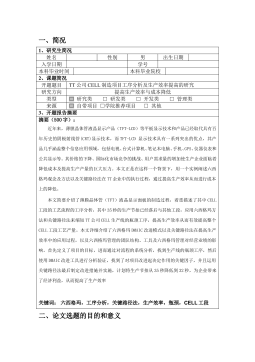IPSec的VPN的研究与实现
VIP免费
IPSec 的VPN 的研究与实现
摘要
随着政府上网、电子商务、金融电子化等不断推进,网络应用越来越广泛,企业和组织
机构不断发展壮大,过去的那种大投入、高消费、低利用的网络建设方式已经不能适应企业
和组织的发展需要。在这种情况下,虚拟专用网(Virtual Private Network, VPN)技术应运
而生,它综合了传统数据网络的性能优点和 Internet 网络结构的优点,彻底改变了传统网
络的建设方式,符合企业和组织发展的需求,代表了当今网络发展的最新趋势。但需要指出
的是:如果在未采取安全措施的虚拟专用网上传输数据时,数据容易被监听、篡改和伪造,
将会给企业和组织造成难以估量的损失。
针对 Internet 的安全需求,因特网工程任务组(IETF)于 1998 年 11 月颁布了 IP 层安全
标准 IPSec(IP Security)。其目标是为 IPv4 和 IPv6 提供具有较强的互操作能力、高质量和
基于密码的安全。IPSec 在网络层发挥作用,对传输的 IP 包进行保护和认证,它提供了在
Internet 这样无保护的网络中传送敏感信息的安全保证。IPSec 实现多种安全服务,包括访
问控制、无连接完整性、数据源验证、抗重播、机密性(加密)和有限的业务流机密性。
本文首先介绍了 VPN 所涉及的各项安全技术,包括隧道协议、加密技术、认证技术等,然
后分析了基于 IPSec 协议的 VPN 网络安全体系结构以及各组件的功能、工作方式,并在此基
础上给出了一种 IPSec VPN 的具体实现,提出了使用协议开关表和 Linux的 NetFilter 机制
将 IPSec 处理嵌入 IP 处理中;使用哈希表实现安全关联库;使用Radix结构实现安全策略库
的设计思想,并着重讨论了框架结构、关键技术。最后通过一个应用实例进行验证和测试。
关键字:传输安全,虚拟专用网,隧道协议,IP 安全协议,安全联盟,封装安全载荷协议,
验证头协议,公共密钥基础设施
IPSec 的VPN 的研究与实现
Abstract
With the development of E-Government, E-Business, E-Finance, we have entered an
information era, which is based on the Internet. With the development of enterprises and
organizations, it' s not fit for them to set up the networks by high investments, high consumption
and in return by low value in use. VPNs technologies were developed in that time, which make full
use of the benefits of conventional networks and the structure of Internet. VPNs, which completely
change the situations and fit for the need of enterprises and organizations, are the trend of networks
development. But we should give attention to the security of VPNs. If the hackers sniff, alter or fake
the unprotected data while transferring through public networks, it may cause incalculable loss.
With much concern to networks security, Internet Engineering Task Force (IETF) provided the IP
security guarantee for transferring sensitive information in an unprotected network in Nov., 1998.
IPSec provides these security services at the IP layer. It protects and authenticates IP packets
transferring between IPSec devices. With IPSec, data needn't worry about being sniffed, altered or
faked while transferring through Internet. IPSec is a framework of open standards that provides data
confidentiality, data integrity, and data authentication between participating peers. IPSec makes the
Virtual Private Networks (VPNs) available.
In this paper, we introduce security technologiesused in VPN, such as tunneling protocol,
encryption, authentication and so on, and explainthe architecture of VPN based on the protocol of
IP Security (IPSec). After these, we propose the realization of IPSec VPN. In the realization, we
discuss the design of implementing the transaction of IPSec with the protocol switching table and
the NetFilter mechanism in Linux, implementing Security Association Database (SAD) with Hash
table and implementing Security Policy Database (SPD) with the structure of Radix tree. We also
discuss the architecture and key technologies in detail. Finally, we use an example to test this
syatem.
Key words: the security of transport, Virtual Private Network VPN), Tunneling Protocol, IP
Security Protocol (IPSec), Security Association (SA), Encapsulating Security Payload (ESP),
Authentication Header (AH), Public Key Infrastructure (PKI)
IPSec 的VPN 的研究与实现
目录
摘要......................................................................................................................................................1
Abstract................................................................................................................................................2
第一章 绪论.........................................................................................................................................6
1.1课题研究背景........................................................................................................................6
1.2 国内外研究状况....................................................................................................................7
1.3 课题的研究意义....................................................................................................................8
1.4 本文的主要内容....................................................................................................................8
第二章 虚拟专用网.............................................................................................................................9
2.1 VPN 概述................................................................................................................................9
2.1.1 VPN 的产生.................................................................................................................9
2.1.2 实施 VPN 的优点........................................................................................................10
2.1.3 VPN 的分类.............................................................................................................10
2.2 VPN 的关键技术..................................................................................................................11
2.2.1 隧道技术...................................................................................................................12
2.2.2 用户认证技术...........................................................................................................12
2.2.3 数据加密技术...........................................................................................................13
2.3 VPN 的实施方案................................................................................................................14
2.3.1 PPTP..........................................................................................................................14
2.3.2 L2TP..........................................................................................................................15
2.3.3 IPSec........................................................................................................................15
2.3.4 PPTP/L2TPlIPSec 的比较.....................................................................................16
第三章 IPSec 系统概述.....................................................................................................................18
3.1 IPSec 安全体系结构和功能..............................................................................................18
3.2 IPSec 的工作原理..............................................................................................................19
3.2.1外出处理过程...........................................................................................................20
3.2.2 进入处理过程...........................................................................................................21
3.3 安全联盟(SA)......................................................................................................................21
3.4 认证头(AH)..........................................................................................................................22
3.4.1 AH 格式.....................................................................................................................23
IPSec 的VPN 的研究与实现
3.4.2 AH 操作模式.............................................................................................................24
3.5 ESP.......................................................................................................................................25
3.5.1 ESP 数据包格式.......................................................................................................25
3.5.2 ESP 操作模式...........................................................................................................27
3.6 Internet 密钥交换..........................................................................................................29
3.7 本章小结..............................................................................................................................30
第四章 IPSec VPN 的设计与实现....................................................................................................31
4.1 操作系统的选择..................................................................................................................31
4.2 系统的总体框架..................................................................................................................32
4.3 IPSec 处理模块的实现....................................................................................................33
4.3.1 IPSec 处理模块的实施方案...................................................................................33
4.3.2 IPSec 处理模块方总体设计.................................................................................33
4.3.3 对Linux 堆栈的修改................................................................................................35
4.4 IPSec 接收处理的实现......................................................................................................37
4.5 IPSec 发送处理的实现....................................................................................................39
4.6 安全策略模块的实现..........................................................................................................41
4.6.1SAD 模块处理.............................................................................................................41
4.7 SPD 模块处理......................................................................................................................44
4.7.1 SPD 模块的总体设计...............................................................................................44
4.7.2 基于 Radix 树的策略表设计思想............................................................................44
4.7.3 SPD 模块中的关键数据结构...................................................................................46
4.7.4 SPD 模块的实现.......................................................................................................46
第五章 利用 IPSec 构造 VPN 网关和测试......................................................................................48
5.1 结构设计..............................................................................................................................48
5.2 构造过程..............................................................................................................................48
5.2.1系统配置...................................................................................................................48
5.2.2 Frees/WAN 的安装...................................................................................................49
5.2.3 Frees/WAN 的配置...................................................................................................49
5.2.4 具体构造 VPN 网关....................................................................................................51
5.3 VPN 网关测试......................................................................................................................52
5.3.1功能测试...................................................................................................................52
5.4 应用模式测试......................................................................................................................53
摘要:
展开>>
收起<<
IPSec的VPN的研究与实现摘要随着政府上网、电子商务、金融电子化等不断推进,网络应用越来越广泛,企业和组织机构不断发展壮大,过去的那种大投入、高消费、低利用的网络建设方式已经不能适应企业和组织的发展需要。在这种情况下,虚拟专用网(VirtualPrivateNetwork,VPN)技术应运而生,它综合了传统数据网络的性能优点和Internet网络结构的优点,彻底改变了传统网络的建设方式,符合企业和组织发展的需求,代表了当今网络发展的最新趋势。但需要指出的是:如果在未采取安全措施的虚拟专用网上传输数据时,数据容易被监听、篡改和伪造,将会给企业和组织造成难以估量的损失。针对Internet的安...
相关推荐
-
跨境电商商业计划书模版VIP免费

 2025-01-09 9
2025-01-09 9 -
跨境电商方案范文VIP免费

 2025-01-09 6
2025-01-09 6 -
创业计划书VIP免费

 2025-01-09 6
2025-01-09 6 -
xx生鲜APP计划书VIP免费

 2025-01-09 6
2025-01-09 6 -
跨境电商创业园商业计划书(盈利模式)VIP免费

 2025-01-09 6
2025-01-09 6 -
跨境电商计划书VIP免费

 2025-01-09 9
2025-01-09 9 -
绿色食品电商平台项目计划书VIP免费

 2025-01-09 8
2025-01-09 8 -
农产品电子商务商业计划书VIP免费

 2025-01-09 7
2025-01-09 7 -
农村电商平台商业计划书VIP免费

 2025-01-09 8
2025-01-09 8 -
生鲜商城平台商业计划书VIP免费

 2025-01-09 7
2025-01-09 7
作者:朱铭铭
分类:高等教育资料
价格:150积分
属性:51 页
大小:1.46MB
格式:DOC
时间:2024-09-20






